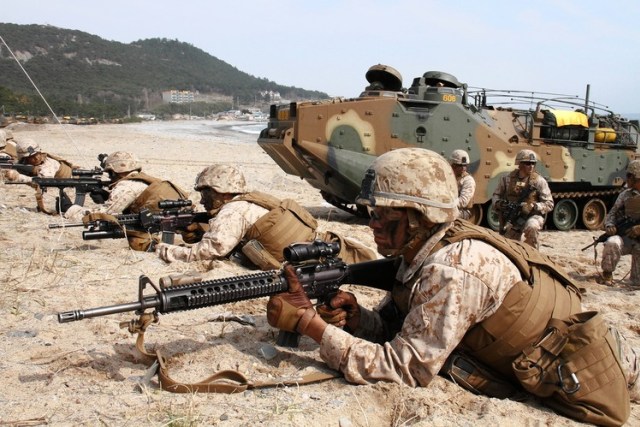
As the United States struggles to maintain influence in the South China Sea, it has pushed Pacific nations to assert themselves against Beijing. In that effort, Washington organized a gathering of military leaders from over 20 countries, specifically excluding China.
An event that was immediately organized and first-of-its kind, the United States hosted the PACOM Amphibious Leaders Symposium in Hawaii for Pacific nation commanders to discuss amphibious military capabilities. In attendance are representatives from Japan, Australia, the Philippines, and 20 other mostly Asia-Pacific nations huddled around a large tactical map, poring over satellite images in readiness for an amphibious raid on Hawaii’s most populous island Oahu.
It represents a glimpse of cooperation and integration among non-Chinese amphibious forces in Asia that the United States is belatedly encouraging.
Early on Tuesday, the foreign amphibious commanders participating in the PACOM Amphibious Leaders Symposium (PALS), boarded Osprey tilt rotor aircraft at Hickam air base, near Honolulu, for a 20-minute ride over the tropical seas around Oahu to the amphibious assault ship USS Essex and other vessels for a demonstration of American marine muscle.
Although this gathering is the first of its kind it signifies a nudge towards containing China, as Beijing grows increasingly assertive in pushing its territorial claims in the South China Sea. A senior U.S. official said.
In the hangar deck after a tour of the 40,000 ton, 266-meter Essex. Martin Sebastian, head of the Maritime Institute of Malaysia said, “I don’t think China can match the advancement and complexity,”
That was likely the impression Washington was hoping to give. For the last few months, the United States has been trying to instill confidence in Pacific allies as tensions over the South China Sea continue to rise.
China was not invited to the symposium because doing so would have contravened a law prohibiting military-to-military exchanges with China at such events. A U.S. spokesman said.
Last year China and more than 20 countries joined in U.S.-led Rim of the Pacific (RIMPAC) naval exercises, but the Chinese military was limited to search and rescue operations during these exercises,
Tuesday’s exercise had involved Ospreys, Harrier jump jet aircraft, armored vehicles, B-52 bombers, and hovercraft. Land a marine units on a beach by boat and helicopter and destroy the fictitious training camp of an insurgent group.
Encouraging Asia-Pacific nations to coordinate their defensive capabilities is a crucial goal of Washington’s military strategy in the region, where 80,000 US troops are already stationed. US officials said.
Recent Chinese reclamation work has stoked tensions in the South China Sea, where Beijing is building man-made islands around seven reefs in the Spratly archipelago that are also claimed by the Philippines and Vietnam.
With a force of around 12,000 marines that it can rapidly expand in times of conflict, China, say military experts, represents a formidable potential foe.
The United States maintains a presence of some 80,000 troops, almost half its strength, in Asia, most on Japan’s Okinawa island at the edge of the East China Sea.
Better integrating the amphibious operations of non-Chinese forces in the Asia-Pacific represents an arduous challenge. Capabilities vary from country to country, gear, including communications, is not interoperable and funding is scarce.
“Capabilities haven’t developed as quickly or as fully as they might,” said Grant Newsham, a former Marine liaison officer to Japan’s Ground Self Defense Force, who attended the meeting.
“The Symposium will hopefully coalesce these ongoing but somewhat disjointed efforts towards amphibious capability.”
Inter-regional rivalries are another hurdle to cooperation.
For example, one participant, who asked not to be identified, said cooperation between Japan and South Korea, which has about 25,000 marines, was impossible because Seoul might one day have to defend territory also claimed by Tokyo.
For some checking out the U.S. military hardware, America’s enthusiasm to forge more capable amphibious forces in the region could provide a more immediate benefit by helping prepare for natural disasters such as super typhoon Haiyan, which killed more than 6,000 people in the Philippines 2013.
“The U.S. is a big brother for the region. It will help enhance the capability we should have.” Alexander Lopez, a Philippine vice admiral said.
“Capabilities haven’t developed as quickly or as fully as they might,” Grant Newsham, former Marine liaison officer to Japan’s Ground Self Defense Force, told Reuters. “The Symposium will hopefully coalesce these ongoing but somewhat disjointed efforts towards amphibious capability.”
The United States has already taken part in a number of joint military exercises in the South China Sea, a region in which it holds no territorial claim. Earlier this year, Washington took part in separate drills with both Indonesia and the Philippines.
Earlier this month, the Pentagon announced it would begin naval patrols of the South China Sea, a decision that many feel could lead to conflict.
Washington has also been busy arming allies in the Pacific.
“What Washington must recognize, however, is that foreign military sales have unintended consequences,” Sean O’Connor, a researcher with the Council on Foreign Relations, told Sputnik. “With more capabilities and vessels deployed in the disputed territory, a small skirmish could ignite an all-out crisis.”





